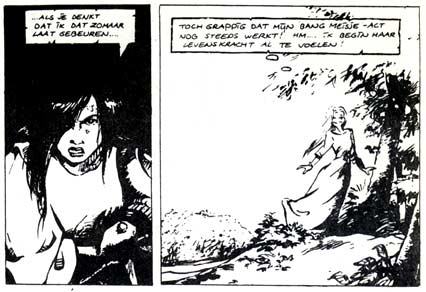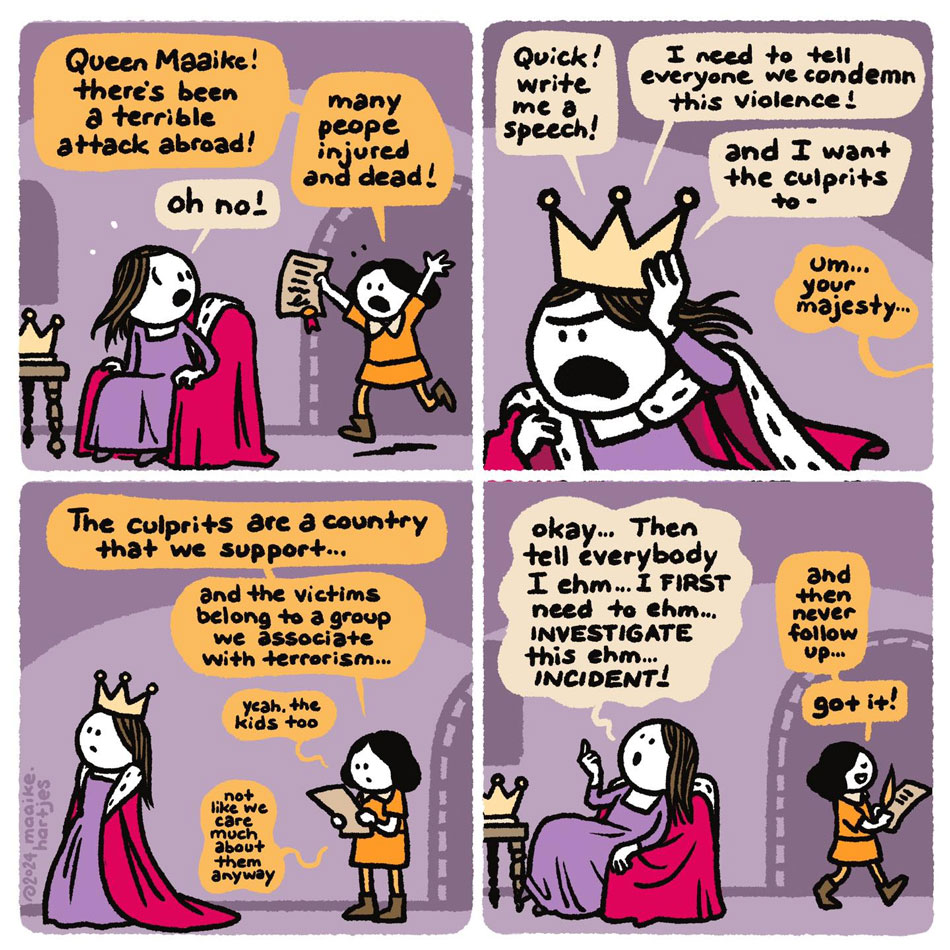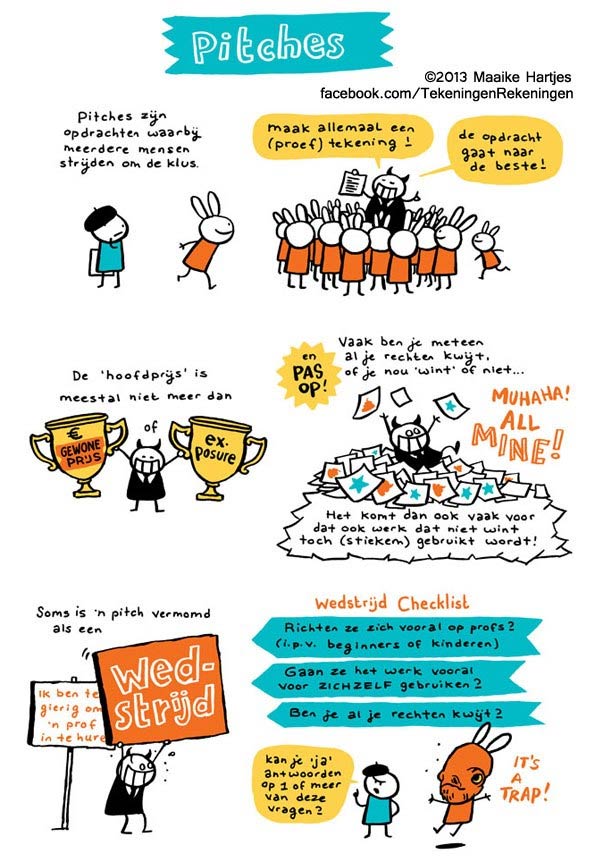Maaike Hartjes is a Dutch comic artist, (live) cartoonist and illustrator from Amsterdam. She rose to prominence during the 1990s wave of alternative cartoonists in the Netherlands, with light-hearted diary comics about her everyday life, which she draws in a minimalistic yet expressive style. Originating from the small-press scene, her work eventually gained a wider audience through publications in the young women's magazine Viva and the newspaper NRC.Next. Later installments of her diary, titled 'Maaike's Dagboek', tackle more serious subjects, such as her travel journals and the critically acclaimed chronicle of her burn-out experiences. Along with Barbara Stok and Gerrie Hondius, Hartjes forms the so-called "Big Three" of Dutch female comics, which popularized the autobiographical genre in their home country.
In the Viva issue of 13 November 2000, Maaike visits comics shop Lambiek. where Barbara Stok is signing her work.
Early life and influences
Born in Amsterdam in 1972, Maaike Hartjes was only six when she started drawing comics based on her own life. As a child she read comics like Willy Vandersteen's 'Suske en Wiske' and the Dutch Donald Duck weekly, while she later developed a passion for 'Thorgal' by Grzegorz Rosinski and Jean Van Hamme and other fantasy comics by Régis Loisel, René Hausman and Yslaire. Later in life Hartjes underwent inspiration from American indie artists, such as Chris Ware and the comic diaries of Joe Matt. She studied Mathematics at the Amsterdam VU university, but dropped out to enroll at the Utrecht School of the Arts (HKU), where she graduated in 1997, in Illustrative Design.
Maaike Hartjes' contribution to the chain comic 'Het Lieve Leven' in Incognito #8 (October 1995).
Comics career
While still a student, Hartjes published her first comics in the Dutch small press scene. She participated in a drawing contest organized by Sjors & Sjimmie Stripblad, and caught the attention of jury member Jeroen Steehouwer. Steehouwer introduced her to his colleagues of Studio Funny Farm in Arnhem, who encouraged her to pursue her ambitions, and especially her diary comics. From 1992 on, Hartjes' artwork appeared in the Funny Farm magazine Razzafrazz, as well as Iris, Robin Schouten's Incognito, Sven van der Hart's De Stripper, Florijn and Michel den Hamer's Zookie-krant. Her work really caught on when it was featured in Zone 5300, an alternative comic magazine launched by Robert van der Kroft and Tonio van Vugt in 1994. One of her homemade mini-comix was even nominated for the 1995 "Album of the Year" award in the category "Dutch original" at the Dutch comic festival of Het Stripschap.
'Lyla'.
De Zwarte Handel
By 1994, Hartjes opened her own studio, De Zwarte Handel, in Amsterdam with Floris Oudshoorn. Apart from them, other artists have frequented the atelier throughout the 1990s and early 2000s, such as Mark Hendriks, Floor de Goede, Ben Westervoorde, Peter Koch and Margreet de Heer.
Stylistic evolution
Originally, Hartjes had developed a realistic drawing style, as showcased in her fantasy epic 'Lyla' in Iris magazine. But in her diary she used more sketchy, miniature doodles, which eventually became her new, trademark style. Her minimalistic characters allow her to capture everyday experiences in just a few lines. They provide a personal and light-hearted touch to her casual, slice of life depictions. She gains inspiration from visits to the supermarket, walks in the city, working in the studio and through her relationship with fellow comic artist Mark Hendriks. Close (artistic) friends like Floor de Goede and Ruben Steeman have regular guest appearances in her strips.
'Maaike's Dagboekje' from the first issue of Zone 5300 (1994). Maaike Hartjes and Floor de Goede introduce themselves to the reader, even though Floor is afraid that she "looks too awful to be seen by so many readers". After explaining who the main characters in their comic will be, the readers complain at the door: "Will there be a punchline?!"
Maaike's Dagboekje
Hartjes self-published several installments of 'Maaike's Dagboekje' ("Maaike's Little Diary") until in 1996 her work was picked up by De Harmonie/Oog&Blik for the first time. With her comic diaries, Hartjes was at the vanguard of a group of female authors who came to notice in the 1990s. Barbara Stok and Gerrie Hondius began creating autobiographical comics around the same time, and the trio were quickly labeled "The Big Three" of female comics. Although Dutch autobiographical comics had been made in the previous decades by Peter Pontiac and Gerard Leever, the 1990s generation popularized the genre. Since then, other authors like Floor de Goede, Michiel van de Pol, Margreet de Heer, Edith Kuyvenhoven, Marq van Broekhoven and Sandra de Haan have followed in their wake.
Some of Hartjes' strips cover more serious issues, in this case the death of the three-year old daughter of her friends.
While Stok and Hondius have always covered serious personal problems in their comics, Hartjes' strips initially contained mainly humorous anecdotes. This changed when she received a weekly half page (2000-2009) in Viva, a magazine for young women. With now a larger audience for her work, Hartjes included more topics that were recognizable to Viva's readers, such as relationship troubles and overall securities. More global themes were also present in 'Maaike's Grote Dagboekje' ("Maaike's Big Diary", 2002), the first extensive collection of her work. Besides episodes of her Viva strip, the book also chronicles the author's correspondence with the Serbian comic artists Aleksandar Zograf and Nikola Vitkovic during the NATO bombings in Kosovo in 1999. De Harmonie/Oog & Blik subsequently released other collections of her work, such as 'Hartjes 1' (2004), 'Hartjes 2' (2005), 'Zo Lief Ben Je Nou Ook Weer Niet!' (2007), 'Hartenjagen' (2009) and 'Gruwelijk!' (2011). A French-language translation of her work was published by La Cafetière in 1999, while samples of her work have also been translated into English, appearing in Roberta Gregory's comic book 'Naughty Bits'.
Besides Viva, Maaike's autobiographical comics and travel chronicles have appeared in NRC.next, De Volkskrant and Francine Oomen's Hoe Overleef Ik magazine. The editors of NRC usually gave her a funny assignment, which she could then cover in her comics reports. For the children's magazine Hoe Overleef Ik (2008), Hartjes made comic strips based on real-life stories submitted by readers. The trips Hartjes and her partner Mark Hendriks made through Asia inspired her to experiment with different lay-outs and graphic styles, often influenced by Japanese design. This became visible in her travel journals, which can be read as a mix of diary and comics journalism. Through a government grant, Hartjes and Hendriks spent a month in the fascinating city of Hong Kong. The chronicle of their journey was a joint effort, published by Oog & Blik under the title 'Hong Kong Dagboek' (2008). In Hong Kong, Hartjes and Hendriks also met Hong Kong comic artist Craig Au Yeung, to whom a chapter in their diary is devoted. When Hartjes traveled to South Africa for a series of workshops, she was confronted with the remains of colonialism and Apartheid, as well as her own prejudices. Her report appeared under the title 'Donker' at De Bezige Bij/Oog&Blik in 2010.
Burn-out diary
In late 2014, an overworked Hartjes suffered from burn-out. Unable to work, the artist managed to find comfort in her comics diary. For months, she wrote and drew an open-hearted account of her severe tiredness, panic attacks, despair, feelings of guilt and the general ignorance about her condition, but also about the support of her family and friends. Graphically, the burn-out diary was a true tour-de-force. Hartjes had incorporated photographs and other snippets in her travel journals before, but now she fully blended her trademark drawing style with the art of collage. Post-its, washi tape, wallpaper pieces, cut-outs, public transport tickets and even tax authorities envelopes were used to construct metaphorical expressions of her emotions and a unique narrative style. Maaike's 300-page 'Burn-out Dagboek' (2018) was eventually released by Nijgh & Van Ditmar, to much critical acclaim.
Following the success of the graphic novel, Maaike Hartjes began working with the animation studios Pupil and Studio Souza on an animated version of the book. The half hour-film, 'I'm Perfectly Fine', premiered in September 2023. A special "movie edition" book was published by Nijgh & Van Ditmar.
Comic strip posted online on 18 September 2024.
Since 2018, Hartjes has continued to post similar diary comic strips on her social media channels, most notably ones about her reflections and experiences with the 2020 COVID-19 pandemic. Since early 2020, she uses an iPad Pro for making her online strips, which have expanded to tackling other social topics like inclusivity, gender issues and institutional racism, but also the hypocrisy of international politics. In January 2023, she started making weekly social commentary strips for the Belgian daily De Morgen.
'Tekeningen Rekeningen'. Note the cameo by 'Star Wars' character Admiral Ackbar, famous for his line: "It's a trap!".
Promotion of comics and creator rights
Maaike Hartjes has always been a strong advocate of comics as an art form and the rights of their creators. In 1997, she compiled a comic book called 'Old Cake Comix', which contained work by solely female creators. Among the 32 contributors were international creators like Amoebe, Roberta Gregory, Maaike Hartjes, Lian Ong, Barbara Stok, Andrea Kruis, José Vonk, Erika Raven, Sheedy, Sylvia Morriën and Jacqueline de Gruyter. With Jean-Marc van Tol, Albo Helm, Mark Hendriks, Marcel Ruijters and Nardja Kerkmeer, she founded the Nukomix collective (2000) in order to promote a different and more innovative form of comics in the Netherlands. In 2011, she accepted a joint chairmanship of the federation of Dutch comic artists BNS, together with Hanco Kolk. During her term (2011-2013), Hartjes strongly focused on copyright and image rights for comic creators. In a series of informative comic strips called 'Tekeningen Rekeningen' (2013), she gave business advice to freelance creatives. In 2017, Hartjes was in the running to be named "Comic Artist Laureate of the Netherlands", along with Margreet de Heer, Pieter Hogenbirk and Robert van der Kroft, but the honor eventually went to De Heer.
Graphic interpretation of Boudewijn de Groot's song 'De Kinderballade' for Strips in Stereo.
Other graphic projects
In addition to her comics, Hartjes provides commercial assignments through Hans Buying's Comic House agency. She makes illustrations in all sorts of styles, and is for hire as a live cartoonist at business events. She has participated in collective projects like 'Strips in Stereo' (2006) and 'Mooi Is Dat!' (2010), to which she contributed comics interpretations of the Boudewijn de Groot song 'De Kinderballade' and Paul van Ostaijen's poem 'Boem Paukeslag!', respectively. Between 2004 and 2006, she wrote the scripts for the comic strip 'Siglo XXV', drawn by Ben Westervoorde and published on the back page of National Geographic Junior.
Recognition
On 28 February 2016, during the Stripdagen in Rijswijk, Hartjes was awarded the Dutch Stripschap Prize for her body of work and commitment to the industry. She reluctantly accepted the prize, but refused to join the jury for next year's award, largely because of her critical opinion about the conservative organization behind the event.
Legacy and influence
Maaike Hartjes has received admiration from veteran artist Gerrit de Jager. She has also been cited as an influence on Michiel de Jong, Niwi, Danny Steggerda and Joost Verweij.
2005 photo collage comic strip, depicting Maaike Hartjes receiving an expensive haircut.














